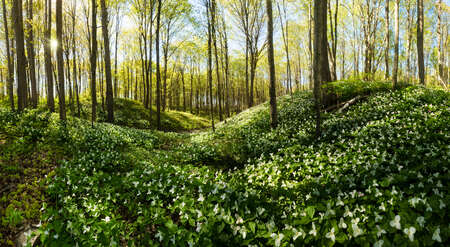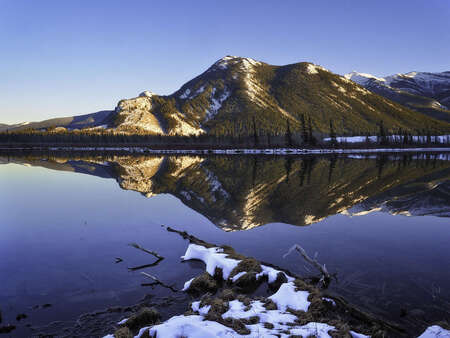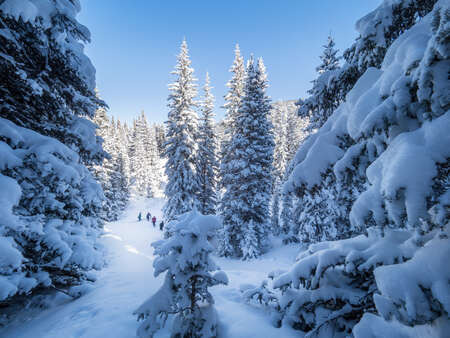Into the Forest I Go
By Peter Baumgarten, Olympus Visionary
"And into the forest I go, to lose my mind and find my soul."
John Muir, Scottish American Naturalist
I'm not big into quoting other authors or famous folk, but when I first read this on a bumper sticker (yes, that's right, a bumper sticker), it struck a chord. I spent my childhood, and much of my adult years, getting lost (figuratively speaking) in the forests around which I lived. Exploring my surroundings has always been a way to let go of the stresses of my daily life and find solace in the beauty of Mother Nature. Photography has become a natural extension of that desire to explore. When it comes to photographing the forest, it does come with its challenges however, but those are outweighed by the countless opportunities.


Capturing the Forest
Photography is all about the light. And for me, that's the biggest challenge when trying to capture a forest scene. Too much sunlight can lead to a very contrasty image. On a sunny day, avoid shooting during midday. With the sun lower in the sky you can reduce some of those harsh shadows. Thin overcast skies can lead to some nice diffuse lighting under the forest canopy. For a moodier shot try shooting at dusk or in foggy or misty conditions.
Another challenge can be the sheer number of trees fighting for your attention. The photograph above is one of the few I've taken within a forest where I was able to capture a panoramic view – 8 shots in total. A small clearing allowed me to shoot a fairly wide view. In tighter quarters I focus on a much smaller section of a well-treed landscape. I love the strong linear elements that this type of composition provides.


The Forest for the Trees
By definition a forest is populated with a multitude of trees. But that congestion can make it quite difficult to create a good composition. It certainly drives homes the old saying that sometimes "you can't see the forest for the trees". That just means that it's time to go hiking! Or driving, in order to get a more elevated view of the canopy. Autumn is definitely my favourite time to strap on the hiking boots and climb to an interesting lookout. That 1970s shag carpet look may not have been the best home fashion statement, but it can look absolutely stunning when Mother Nature does it.



Forest Reflections
Capturing a better view of the forest doesn't always mean finding an elevated lookout. I live in an area dotted with innumerable small lakes, so I often gravitate to these bodies of water to photograph the far shoreline. I'm usually looking for that perfect reflection so it's important to check the wind conditions. Winds usually build during the day and wane close to sunset. As such, I try to get out early or stay out until dusk to improve my chances of success.
One of the most distracting elements in a shot like this can be the sky. Under most circumstances I narrow my focus to a small section of shoreline. This highlights some of the details of the distant forest, simplifies the composition, and provides a more balanced exposure.
If you live in an area without smaller lakes, paths through the forest and small clearings can provide a much more open view and create an interesting landscape shot.






Woodland Streams
The lush foliage of a healthy forest needs to be supported by a good water supply, and in hilly or mountainous areas that often means the presence of woodland brooks and streams. Depending on the location, many of these are seasonal in nature, so good timing may be your best strategy.
If possible, I like to photograph these after a fresh rain, and I try to avoid shooting in direct sunlight. That said, you are still likely to get unwanted reflections from the water's surface, rocks, and the neighbouring foliage. Using a good polarizing filter can reduce that glare considerably and help saturate the colours.
A longer exposure can smooth out the flowing water and create that atmospheric silkiness of the water that many photographers like. A shutter speed between 1/4 and 1/2 second is usually adequate. In the darker conditions of the understory this is should be easy to achieve. If it's a bit bright, lower your ISO to 64 or 100, rather than the recommended 200, or try the Live ND feature - a great way of getting longer exposures without the need for an actual ND filter.


The Forest Floor
I will often go hiking in one of my local woodlots for one purpose – to photograph some of the smaller subjects living there. That means it's time to grab that macro lens... or use the close focusing distance of all the Olympus lenses. Like many things in nature photography, timing is everything. Each season brings with it new opportunities. Spring is the time for wildflowers, a summer rain brings out an explosion of mushrooms, and autumn carpets the floor with freshly fallen leaves. Regardless of the subject, if you are planning on getting in close, pay attention to the depth of field. At closer distances, even a smaller aperture will provide a shallow depth of field. Use focus bracketing and stacking to ensure a sharp subject yet still maintain a soft, defocused background.




A Home for Hiding In
While out for a casual hike I'm not expecting any wildlife encounters, but there have been numerous occasions where that's exactly what happens. Being prepared for the unexpected can make the difference between getting the shot and just watching the wildlife disappear into the trees. On many of my forest hikes I have my camera out, telephoto lens on, and settings dialed in that will give me the greatest chance of success. That means that I'm as ready as I can be should an opportunity arise. Shooting under a canopy of leaves will likely mean that you will need a higher ISO and wider aperture. Under most circumstances I try to keep my shutter speed at around 1/1000 of a second, but this may not be possible in poorer light. With the exceptional image stabilization of the Olympus camera bodies and many of the M.Zuiko lenses I've been able to get away with exposures much slower than that.
Don't want to carry a longer lens on your next hike? Some of my favourite wildlife shots are those taken with a shorter focal length. This helps put the animal in the context of its natural surroundings and can tell a better story. My favourite all-around lens is the M.Zuiko 12-100mm F4.0 IS PRO. It's great for most landscape situations, but can still pull in some more distant subjects.


1/500s | F8 | ISO 1000

Winter Wonderland
In many respects winter is my favourite season for photography, but it's a season often ignored by photographers. A fresh coating of snow can bring new life to a scene and the landscape can change quite dramatically from day to day. Dealing with the elements can be a challenge so dressing for the conditions is critical. If you are not comfortable, you won't have the motivation or patience to try and get the perfect shot.
Getting the proper exposure can also be a challenge in winter. It is your camera's natural tendency to turn bright whites into a dull grey, so bumping up your exposure by up to a full stop can improve the look of your winter forest scenes.


Final Thoughts
For me, photography is really just an excuse to go and explore my surroundings. I always carry my camera into the forest. Sometimes I come back with a great shot, often I don't. But, either way, I always come back with a greater sense of calm. Because, for a short while anyway, I have lost my mind, and found my soul.

ABOUT PETER
Web: creativeislandphoto.com
Blog: creativeislandphoto.com/blog
Twitter: @creativeisland4
Peter has been a dedicated Olympus shooter for nearly 40 years, and has found a way to combine his passion for photography with his love of teaching to develop photography workshops with a focus on landscape, wildlife and astrophotography. Peter’s work has been published in a number of magazines including Canadian Geographic, Shutterbug and Outdoor Photographer. He maintains his own blog with an emphasis on tutorials that assist others in bringing their photography up to the next level.







